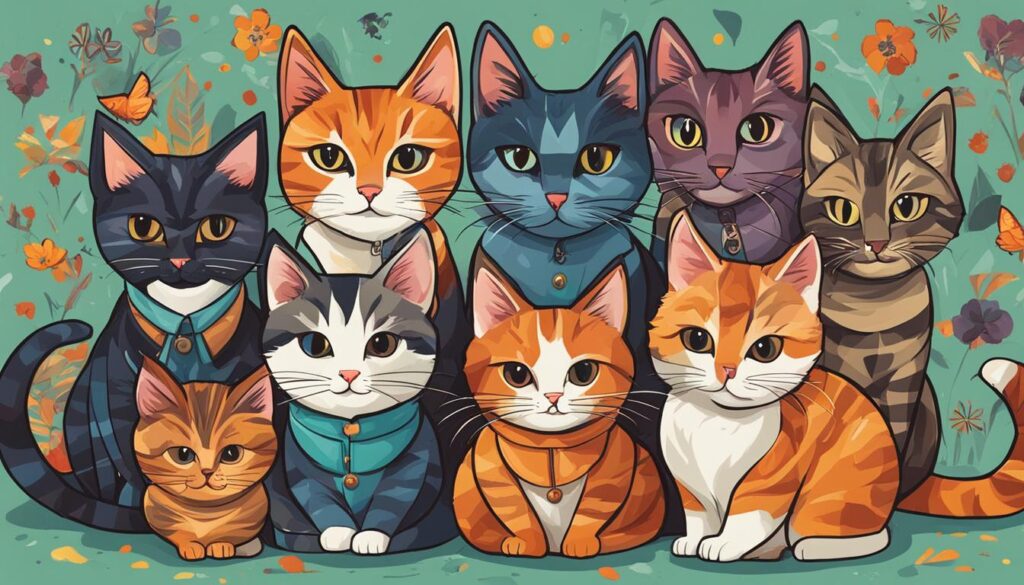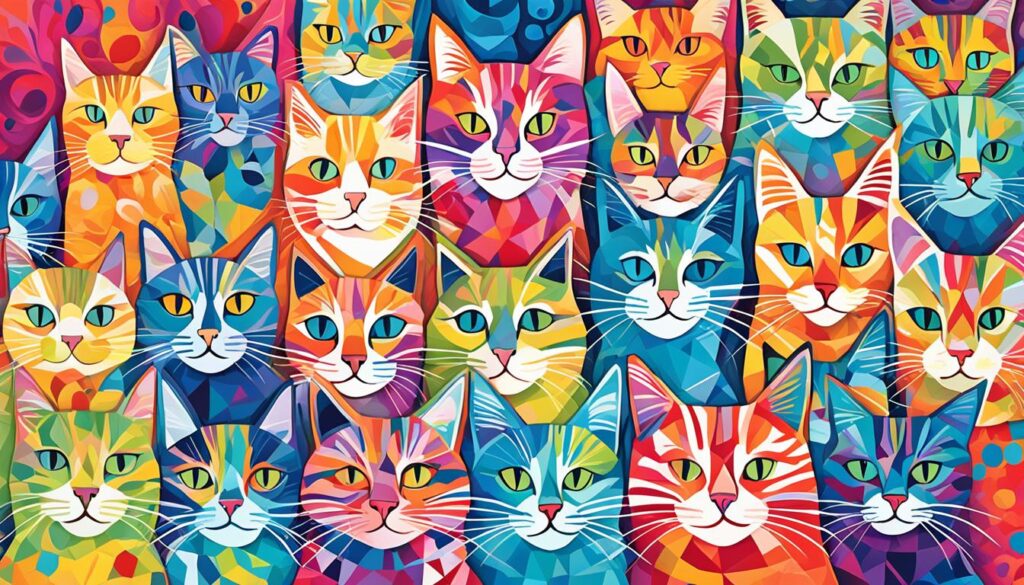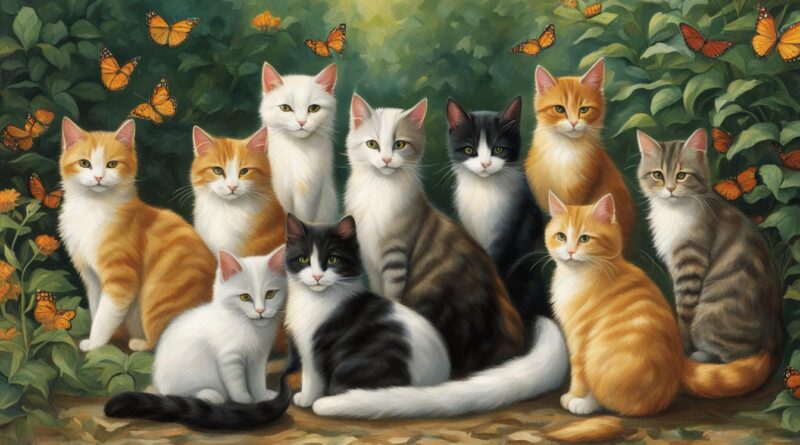Discover What a Group of Cats Is Called Today!
Have you ever wondered what a group of cats is called? Well, you’re in for a treat because we’re about to uncover the fascinating world of cat group names and collective nouns for our feline friends. Whether you prefer domestic cats, wild cats, or feral cats, there are unique terms to describe their gatherings. Let’s dive right in and explore the diverse and intriguing world of feline group terminology.
Key Takeaways:
- The most common term for a group of cats is a clowder, but there are other names like clutter and glaring.
- Groups of wild or feral cats have specific names such as dowt and destruction.
- A group of young cats is called a kindle of kittens.
- The term “clowder” has historical roots and is derived from the English word “clotern.”
- Cats may form groups for survival, social bonding, and protection, but they often hunt individually.
Uncover the Origins of the Term “Clowder”
Have you ever wondered where the term “clowder” comes from when referring to a group of cats? The history and etymology behind this unique cat group name are fascinating.
The word “clowder” originates from the English word “clotern,” which is related to other words like “clot,” “clutter,” and “cluster.” These words all share the common theme of gathering or accumulation. When applied to cats, the term “clowder” represents the idea of cats coming together or hanging out as a group.
According to Teresa Keiger, the creative director of the Cat Fanciers’ Association, the etymology of “clowder” adds an interesting layer of history and linguistic connection. It reflects the natural behavior of cats to gather and socialize with other cats, creating a sense of community and companionship.
“The term ‘clowder’ beautifully captures the essence of cats coming together, forming a cohesive group. It represents their innate social nature and their ability to form strong bonds with one another.”
The origin of the term “clowder” showcases the rich history and evolution of cat group names throughout the years. It highlights the importance of language and how it can encapsulate the nuances of feline behavior and interactions.
To gain a deeper understanding of cat group terminology, let’s take a closer look at the various names used to describe these feline gatherings.
Evolution of Cat Group Names
| Term | Meaning |
|---|---|
| Clowder | A group of cats |
| Clutter | An alternative term for a group of cats |
| Glaring | Another term used to describe a group of cats |
| Dowt/Dout | A collective noun for a group of wild or feral cats |
| Kindle | A group of young cats or kittens |
| Destruction | A specific term for a destructive group of cats |
As seen in the table above, there are various terms used to describe groups of cats, each with its own unique meaning and context. From the commonly known “clowder” to the lesser-known “glaring” and “dowt,” the world of cat group names is diverse and intriguing.
The image above showcases the intriguing origin of the term “clowder” and its connection to the English word “clotern.” This linguistic link highlights the historical and cultural significance of cat group terminology.
Exploring Other Terms for Groups of Cats
While “clowder” is the most commonly recognized term for a group of cats, there are other words that can be used to describe these feline gatherings. Some alternative names include “clutter,” “glaring,” “nuisance,” and “doubt.” These terms offer different perspectives on how cats come together and interact within a group. It is fascinating to explore the linguistic variety in cat group terminology and the nuances each word captures.

Understanding the Role of Grouping in Cat Behavior
Cats are known for their independent nature, but they have the capacity to form groups under certain circumstances. While they may typically prefer to roam and hunt alone, there are reasons why cats come together and exhibit social behavior.
“Cats are typically solitary creatures, but they may form groups if survival depends on it.”
Before cats were domesticated, they roamed freely around houses and barns, often congregating in search of food. This behavior continues in feral cat colonies, where cats live together for protection, companionship, and social bonding. Grouping provides a sense of security and helps them navigate their environments more effectively.
Unlike pack animals like dogs or wolves that hunt in coordinated groups, cats in a group often hunt separately. This is because cats are skilled solitary hunters, and their individual hunting techniques and strategies are more effective when employed alone.
Within a group of cats, a hierarchy may develop to establish social order and minimize conflicts. This hierarchy is typically determined through various forms of communication, including body language and vocalizations. Owners of multiple cats should be aware of these dynamics and take steps to foster a harmonious environment.
To summarize, while cats are primarily solitary creatures, they can form groups for survival, social bonding, and protection. Understanding the reasons behind cat grouping and the hierarchy among cats helps cat owners provide a conducive environment for their feline companions.
Unique Names for Individual Cats
In addition to group names, cats also have unique terms to distinguish individual felines based on their gender and life stage. These specific names add an extra layer of depth and personalization to our furry friends. Let’s explore some of these fascinating cat individual names:
Male Cats:
- Tom: This is a common name for male cats, often associated with their independent and adventurous nature.
- Gib: A neutered male cat is referred to as a gib. Neutering is a procedure that helps control cat populations and ensures a healthier lifestyle for them.
Female Cats:
- Molly: Molly is a popular name given to female cats. It reflects their grace, elegance, and nurturing nature.
- Queen: When a female cat is pregnant, she is affectionately known as a queen. This term highlights the special role she plays in bringing new life into the feline world.
Just like humans, cats have unique personalities and traits. These individual cat names contribute to the rich tapestry of feline terminology, allowing us to recognize and appreciate the distinct characteristics of each cat.
Whether you have a tom, molly, gib, or queen, these individual cat names reflect the diversity and beauty of our feline companions.

Fun Cat Idioms and Expressions
Cats have a special place in the English language, inspiring a myriad of idioms and expressions. These phrases not only add a touch of humor but also reflect our enduring fascination with these enigmatic pets. Here are some popular cat-related idioms and expressions:
“The Cat’s Pyjamas”
“The cat’s pyjamas” is used to describe something fantastic or extraordinary. This phrase originated in the Roaring Twenties, a time when people celebrated Jazz Age glamour and elegance. The term “cat’s pyjamas” illustrates the idea that cats are known for their poise, grace, and impeccable style.
“Raining Cats and Dogs”
“Raining cats and dogs” is a well-known idiom that indicates heavy rainfall. While the origin of this phrase remains unclear, it is believed to have roots in ancient mythology. The phrase may symbolize the chaotic and uncontrollable nature of heavy rain, akin to cats and dogs falling from the sky.
“Curiosity Killed the Cat”
“Curiosity killed the cat” is a cautionary idiom that warns about the dangers of being too curious or nosy. The phrase emphasizes the idea that being too inquisitive can lead to trouble or unfortunate consequences. It serves as a reminder to strike a balance between curiosity and caution.
These cat-related idioms and expressions not only bring a smile to our faces but also highlight the significant role cats play in our language and culture. Their charm, mystery, and playful nature make them an endless source of inspiration.
Continue reading to further explore the intriguing world of cat group names in the next section of this article.
Conclusion
Learning about the variety of names for a group of cats adds a fun and interesting dimension to our understanding of feline behavior and language. From the commonly used term “clowder” to the more unusual terms like “clutter” and “glaring”, each word captures a unique aspect of cat groups. These collective nouns reflect the diversity and complexity of cat social interactions.
Moreover, exploring individual cat names and cat-related idioms provides further insight into the cultural significance and symbolism associated with these beloved pets. Whether it’s the classic names “tom” for a male cat or “queen” for a pregnant cat or the idiomatic expressions like “the cat’s pajamas” and “raining cats and dogs,” cats have left their mark on our language and cultural imagination.
So now you know, the next time you encounter a clowder of cats, you can impress your friends with your knowledge of their official group name. Dive deeper into the fascinating world of cat terminology and discover the unique ways in which humans have described and understood these enigmatic creatures throughout history.
FAQ
What is a group of cats called?
A group of cats is commonly called a clowder. Other terms include clutter, glaring, and doubt.
What is the origin of the term “clowder”?
The word “clowder” originates from the English word “clotern” and is related to words like “clot,” “clutter,” and “cluster,” which denote the gathering or accumulation of objects or organisms.
Are there any other names for groups of cats?
Yes, alternative names for groups of cats include clutter, glaring, nuisance, and doubt.
Do cats naturally form groups?
Cats are typically solitary creatures, but they may form groups for survival purposes, such as in feral cat colonies where cats live together for protection and social bonding. However, cats in a group often hunt separately and may develop a hierarchy among group members.
Are there specific names for individual cats?
Yes, a male cat is commonly called a tom, while a neutered male cat is known as a gib. Female cats are referred to as molly, and a pregnant cat is called a queen.
Are there any idioms or expressions related to cats?
Yes, there are several idioms and expressions involving cats in the English language, such as “the cat’s pyjamas” (meaning something fantastic) and “raining cats and dogs” (indicating heavy rain).
What can we learn from the variety of cat group names?
Exploring the diverse names for groups of cats provides insight into feline behavior and language, while individual cat names and cat-related idioms offer further cultural significance and symbolism associated with these beloved pets.


